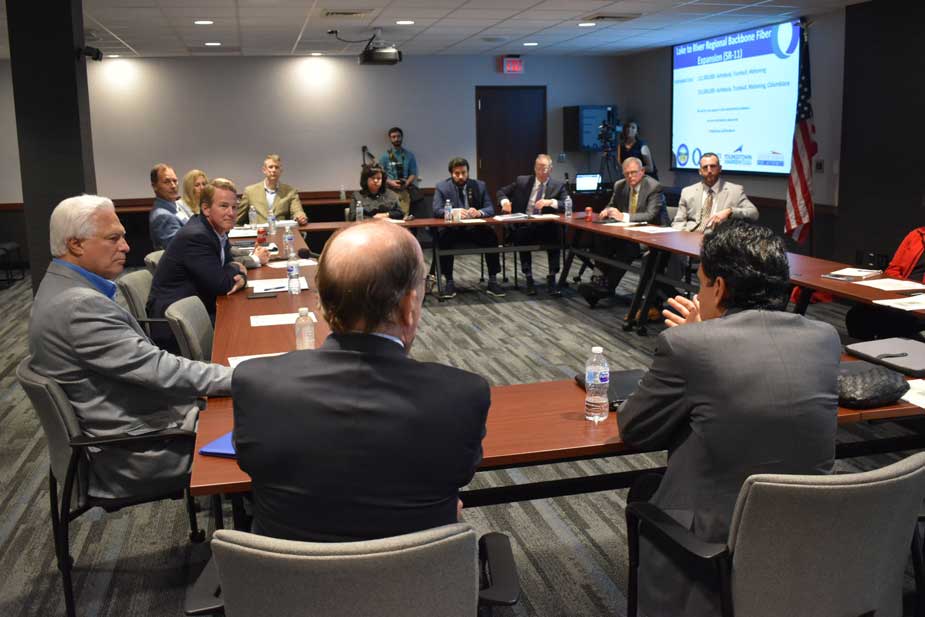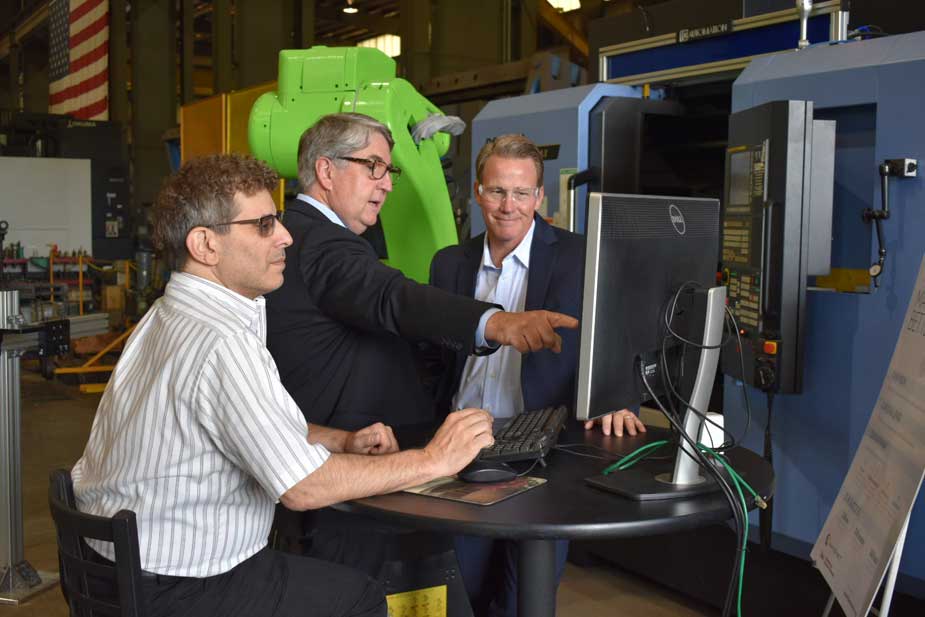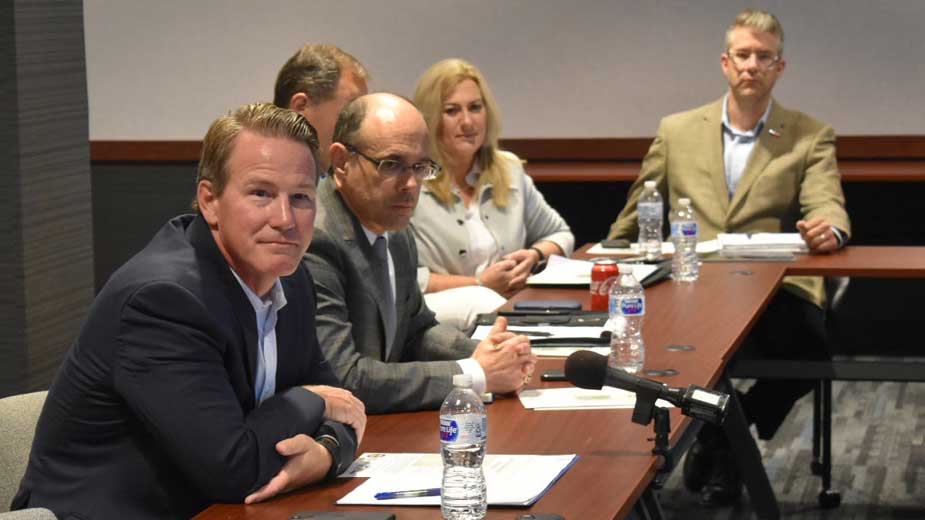‘Failure Is Not an Option’: Husted, Local Leaders Back Broadband Expansion
YOUNGSTOWN, Ohio – Lt. Gov. Jon Husted is confident that the Ohio General Assembly will restore funding for broadband programs that the Senate took out of the proposed state budget when it approves the final bill.
Husted participated in a Wednesday afternoon roundtable with local business leaders and community stakeholders hosted by Eastgate Regional Council of Governments and the Youngstown/Warren Regional Chamber. It was one of two events on his agenda during his visit.
The lieutenant governor stressed the importance of expanding broadband access during the roundtable, which was held at Eastgate’s offices downtown.
“You literally cannot participate in the modern economy, education or health-care system without it,” he said.
Following initial attempts to work with private-sector providers – including companies “that go to Capitol Hill and say they want to close the digital divide” – Gov. Mike DeWine and Husted ran a series of pilot projects and eventually secured $20 million from the General Assembly to establish a grant program.
For the fiscal year that begins July 1, the Ohio House of Representatives funded $190 million of the $250 million in additional funds the DeWine administration requested, only for the Senate to withdraw the funds and to place restrictions on how broadband funds can be used.

Husted predicted that the General Assembly would reverse course.
“We’ve had enough people speak out about this that it’s likely that the prohibitive language in the budget will be removed. It’s likely that a good portion of the money that we have asked for will be restored, but you never know until it’s over,” he said. “We will keep pushing until the very end.”
Failing to act would make Ohio “a backward state,” he warned. “Failure is not an option on this one.”
Eastgate, which recently completed a broadband feasibility study, is working with Broadband Ohio, a state office dedicated to improving access to high-speed internet across Ohio, to submit a proposal for a lake-to-river regional backbone fiber expansion. Running along the nearly 100 miles of state Route 11 from Ashtabula County south to Columbiana County, the high-speed fiber line would serve more than 620,000 people.
The study found that Youngstown is the second-most unconnected city in Ohio, said Jim Kinnick, Eastgate’s executive director. Warren ranked fifth in being unconnected and Niles 20th.
“Prior to the pandemic, we thought the focus was just on rural areas that don’t have access and urbanized areas that just have slow speed,” Kinnick said. “The pandemic has certainly pointed out the affordability issue.
Eastgate is looking for partners in the region for projects to address that aspect.
“No doubt we have to tackle the affordability,” Husted said. “If you can’t afford it, you might as well not have access to it. It’s the same thing.”
Installation of the backbone fiber and “last mile” expansions from it were identified in Eastgate’s study as two of the long-term solutions to improving broadband access. The estimated cost for the fiber line to run through Ashtabula, Trumbull and Mahoning counties is $12 million. Extending the line through Columbiana County would bring the cost up to $15 million.
If the state approves the grant application, Eastgate would include in its request for proposals that spurs would be installed east and west of the backbone line to feed underserved areas, Kinnick said.
“No provider is going to front this money,” Kinnick said. “The government is going to have to front the money.”
Even if the General Assembly restores the funds requested for the grants, the program won’t solve all of Ohio’s broadband problems but “should serve as a template to do that,” Husted said. The state has already received requests totaling more than $250 million for its grant funds, but the lieutenant governor also is looking to the state’s share of American Rescue Plan funds as well as ARP funds going to local jurisdictions.
“You have to make the most of your opportunities in life, but when we don’t do the things that are necessary to get people the opportunity, then we’re shortchanging them,” Husted said.
Businesses that increasingly are turning to virtual career fairs lament the low participation among lower-income communities, reflecting the lack of access.
“The business community definitely sees a need for this,” said Guy Coviello, the Regional Chamber’s president and CEO.
“If we want to have an inclusive recovery, we want to help people make the most of their opportunities in life,” Husted said. “This is a fundamental infrastructure issue that must be resolved.”

Following the roundtable, Husted went to M7 Technologies to see some of the results of the state’s TechCred program, which reimburses businesses for costs associated with upgraded skills in approved credentials.
“It’s helped us tremendously,” said Michael Garvey, M7’s president. “As we develop technology like you’re witnessing now, we’re going to need to upskill our workforce.”
Husted spoke with workers who had benefited from TechCred and watched as they demonstrated equipment in the Ohio Works Drive plant. He also visited Center Street Technologies, a large-scale 3D printing company that Garvey also operates.
“They learned skills that will help make them better employees, that will help make the company more competitive. That’s why we designed this program,” Husted said. “We need to continue to build on this because the way we’re going to compete, the way we’re going to improve quality of life, the way we’re going to beat the rest of the world is through talent.”
Pictured: Lt. Gov. Jon Husted (left) and Youngstown/Warren Regional Chamber President Guy Coviello (second from left) were among those urging support for expanding broadband access in the Valley.
Copyright 2024 The Business Journal, Youngstown, Ohio.



